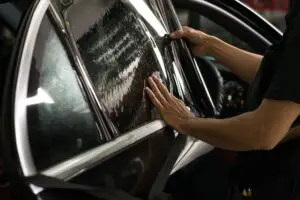Window tint laws have been a thing in Kansas since 1987, and the state has made sure to update them over the years, so if you could use a refresher, don’t worry, as this article has you covered.
Kansas window tint laws and very easy to understand. For all cars, the windshield must use a non-reflective tint which must be over the manufacturer AS 1 line.
To be legal for the rest of the windows, you must have at least 35% of the light pass through them from the tints.
While that was the main crux of Kansas’s window tint laws, there is still a lot more to talk about, so make sure to read the whole article to learn everything there is about the tint laws in Kansas.
Table of Contents
- 1 How Much Tint Darkness Is Legal In KKansas?
- 2 Window Tint Reflection And Tint Colors
- 3 Medical Exemption Of Window Tint Laws In Kansas
- 4 Get A Certified Sticker From The Company
- 5 Other Window Tint Law Rules And Regulations In Kansas
- 6 Cost Of Car Window Tint In Kansas
- 7 Frequently Asked Questions
- 8 Conclusion
How Much Tint Darkness Is Legal In KKansas?

The legal requirement that Kansas has imposed on all cars and vehicles seems to be 35% VLT.
If your window tints do not allow at least 35% of the light to pass through them, they are not street legal, and hence driving in them will be breaking the law.
Tint Darkness Limit For SUVs And Vans
The laws and rules in place for sports utility vehicles and vans are the same ones set for all the other cars, making them a lot easier to learn.
Firstly, you have the windshield; a window that is not allowed to have any sort of reflective tints whatsoever.
Any tint you apply on the windshield must be well over the AS 1 line set by the manufacturer.
Moving on to the front seat side windows, you get the state’s main restriction trend, which says that the VLT requirement for window tints is 35%.
This rule is then valid for the back seat side windows, which must have 35% of the light be able to pass through them, and applies to the rear window as well, with the same requirements.
This makes it very easy to remember the rules, as all you need to remember is that the windows must be over 35% VLT.
Tint Darkness Limit For Sedans
Sedans continue this trend of requiring 35% of the light to go through the windows. Here is a per window requirements list just to be safe.
1. Front Windshield
However, the windshield is quite different and has a varied set of rules, including no reflective tints and making sure that the tint you use is over the AS 1 line set by the manufacturer of the vehicle.
2. Front Seat Side Windows
The state of Kansas allows all manner of window tints on the front seat side windows such that at least 35% of light can pass through them.
3. Rear Window
Moving back to the rear windows, you get the same VLT requirements of 35% for the window tints to be legal.
4. Back Seat Side Windows
This continues for the back seat side windows, which must have at least 35% VLT if you want to follow the rules to the letter.
Window Tint Reflection And Tint Colors
- The state of Kansas does not allow the use of tints that give off a metallic appearance on the front and back seat side windows.
- This is true for tints that give off a mirrored appearance and are limited to the front seat and back seat side windows.
- You are allowed most colored tints in the state of Kansas.
- The tints which are not allowed are the following:
– Red
– Amber
– Yellow
Medical Exemption Of Window Tint Laws In Kansas

If you have a medical condition and cannot be in the sun for too long, then many different states should give you some benefits in the form of medical exemptions to these window tint rules, making it legal for you to get darker and special tints.
Unfortunately for you, Kansas does not allow any sort of medical exemptions, which means that everyone must follow the rules that are set in place.
Regardless of your condition or the recommendations of licensed doctors and physicians, you cannot use special tints which break the VLT requirements set by the state, and doing so will lead to a Class C misdemeanor.
Get A Certified Sticker From The Company
Other states would have you keep various documents and place stickers on your car to ensure that the tints you are using are legal in all cases.
This is usually taken one step further by asking the manufacturers of the tint films to certify that their products are legal.
Luckily for those living in Kansas, the manufacturers are not required to certify that their film is legal in the state of Kansas.
The people who apply the window tints are encouraged to apply stickers that help law enforcement identify that their tints are street legal, but they are not legally required to do so.
You will not be breaking the rules if you do not have any certifications or stickers.
Other Window Tint Law Rules And Regulations In Kansas
Here are a few other window tint laws which you should know when living in the state of Kansas:
- If your rear window is tinted, you are legally required to use dual-sided mirrors.
- You can use colored window tints as long as they are not the colors mentioned above.
- You are not required to have any certificated or sticker to provide local law enforcement.
- There are no medical exemptions in Kansas State.
Cost Of Car Window Tint In Kansas
While the general cost will vary, you can easily be looking at $150 or more for a basic tint. This will only get more expensive as you increase the number of windows or move up in quality.
Ceramic window tints and other premium-quality ones can cost you well over $400 per vehicle.
This can go even further if you decide to go for colored tints or those with an extended warranty.
You can also just resort to a DIY tint kit which can save you $50 and simply cost $100, but this will only get you a basic tint, and you will have to do it yourself, which can be tedious if you are doing it for the first time.
Frequently Asked Questions
Q1. Is 15% Tint Legal In Kansas?
With the requirements of all car windows to be at least 35%, 15% tints are completely illegal in Kansas, and you will be breaking the law if you apply these to any of your windows.
Q2. Are 5% Tints Legal In Kansas?
As with the 15% tints, the 5% tints follow the same rules and hence are illegal.
You should try your best to avoid these tints if you are a citizen of Kansas State and opt for tints that are confirmed to have 35% VLT.
Q3. Is Limo Tint Legal In Kansas?
Limo tints can also get very dark and block out a lot of light, making them most likely to fall below the required threshold. This means that you should avoid limo tints as well.
Q4. Can I Get Pulled Over For Tint In Kansas?
You can, without a doubt, get pulled over by the authorities if they suspect that your window tints are too dark and follow the laws of the state.
This will trigger them to conduct a tint test and act accordingly, so make sure that your tints are street legal.
Q5. How Much Is A Tint Ticket In Kansas?
As mentioned above, getting a tint ticket is a Class C misdemeanor which means that if you are caught using tints that are darker than what they should be, then you are liable to get a fine that can easily reach up to $500, which is a good incentive to follow the law.
Conclusion
Kansas tint laws are easy to remember since none of them demand a lot from you.
You must remember that all the tints on your windows must allow at least 35% of the outside light to enter the vehicle. As long as that happens, most of your worries should disappear.
Now that you have read the article, you should be easily able to follow the rules and regulations set by the state of Kansas on window tinting and know everything to avoid any trouble with the police.

I am Tahir Azam, and I have been writing amazing articles for TaxiHack for as long as I can remember. I know everything that is to know when it comes to automobiles and is always on top of industry news and developments. While I am not an expert by any means, I pride myself on knowing the ins and outs of many different problems and, of course, their solutions. The articles on our website are some of the best and well-researched content that you will find, and I spend countless hours making sure this remains to be true. This is why I ask you to take your time out and read some of my articles, especially if you find a topic that resonates with you or is something you are looking into. This way, you will find the perfect mix of information and tips on your desired topic. Learn more about Tahir.




